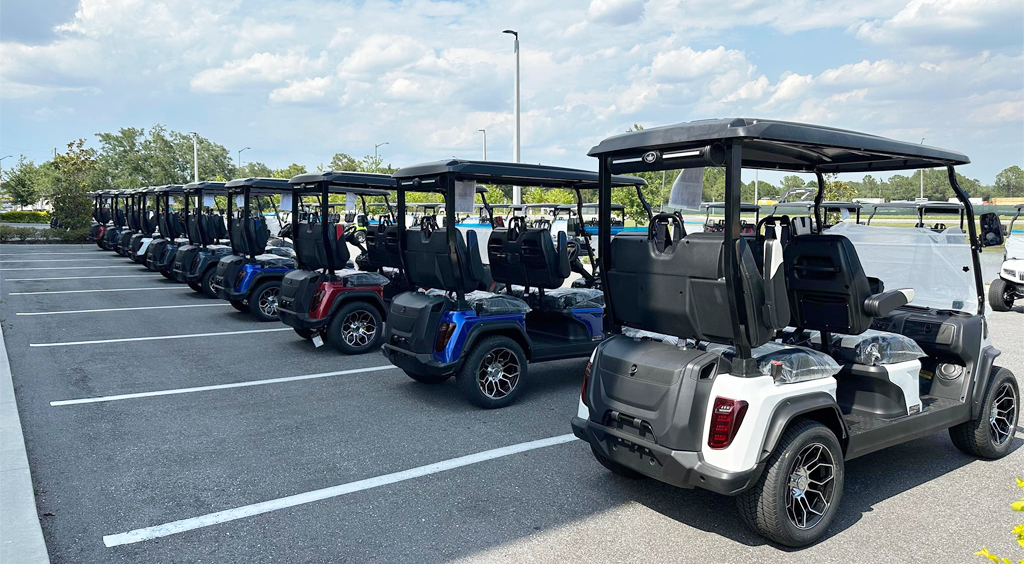Electric golf carts are popular because they are environmentally friendly, quiet to operate and easy to use. A key factor that greatly affects the performance and functionality of an electric golf cart is the chassis. The chassis is the foundation of an electric golf cart, providing it with structural support and a platform on which other components such as motors, batteries, suspension and steering structures can be mounted. In this article, we will explore the key components of an electric golf cart chassis and the impact of the chassis design has on the overall performance and user experience.
The chassis of an electric golf cart consists of several key components, each of which plays a critical role in ensuring the structural integrity and functionality of the vehicle.
Frame.The frame, forming the core of the chassis, is typically made from steel or aluminum. This provides strength and durability while keeping the golf cart’s weight in check. A well-designed frame balances stiffness and flexibility, offering smooth handling and consistent performance across different terrains.
Suspension System. The suspension system consists of springs, shock absorbers and other components that connect the wheels to the chassis. This helps to reduce the shock and vibration from rough terrain, providing a comfortable and stable ride. The design of the suspension system determines the handling characteristics, ride quality, and overall stability of the golf cart.
Motor. The motor, being the power source of a golf cart, has an installation design that affects its weight distribution and overall balance of the cart, which in turn affects its performance and handling. The chassis can provide mounting points for the motor so that the motor can be securely mounted on the chassis to ensure efficient power transfer and stable operation.
Battery Compartment for Lithium-Ion Batteries.Electric golf carts are powered by lithium batteries, which are usually located in a dedicated compartment within the chassis. Battery boxes must be designed for ease of maintenance, safe installation, and proper ventilation to maintain battery performance and longevity.
Steering Structure. The chassis houses the steering components, including the steering column, rack-and-pinion system, and steering gear interlock. The design of the steering structure affects the golf cart’s responsiveness, precision and maneuverability, which in turn affects the overall driving experience. Design Considerations for Electric Golf Cart Chassis When designing the chassis of an electric golf cart, several factors must be considered to ensure optimal performance, safety and user comfort.
1. Weight distribution. Proper weight distribution is critical to maintaining stability and traction, especially when traveling on slopes and rough terrain. Chassis design should aim to evenly distribute the weight of batteries, motors, and other components, to prevent overloading of specific areas, and to maintain a balanced center of gravity.
2. Ground clearance. The chassis should be designed to provide sufficient ground clearance to prevent the golf cart from bottoming out or becoming stuck on an obstacle. Ground clearance also affects the off-road capability of the cart and its ability to travel over rough terrain without damaging the chassis or other components.
3. Durable and resistant to corrosion. Electric golf carts are often used in outdoor environments, and the chassis is inevitably affected by various environmental conditions such as moisture and mud. As a result, chassis materials and coatings should be chosen to withstand corrosion and ensure long-term durability, thereby reducing maintenance requirements and extending the life of the golf cart.
4. Easy to maintain. Chassis designs should provide easy access to critical components for routine maintenance and repair. These include features such as removable panels, accessible battery boxes, and serviceable suspension and steering components, allowing maintenance tasks to be performed efficiently with minimal downtime.
5. Mobility and turning radius. The chassis design affects the turning radius and maneuverability of a golf cart. A well-designed chassis allows for a tight turning radius, making it easier to maneuver through narrow aisles and confined spaces, and is a key factor in handling golf course environments and congested areas.
In addition, the design of the electric golf cart chassis directly affects the performance of the vehicle and the overall user experience, specifically in the following areas:
1. Ride quality. A well-designed chassis and fine-tuned suspension provide a smooth and comfortable ride that minimizes vibrations and bumps caused by rough terrain. This is especially important to provide golfers with a pleasant driving experience that ensures they can focus on their game without distraction.
2. Controllability and stability. Chassis design plays an important role in determining the handling and stability of a golf cart. A stiff, well-balanced chassis contributes to predictable handling, stable cornering and enhanced overall vehicle control.
3. Off-road capability. Electric golf carts are frequently used for off-road activities, including golf courses with varied terrain. The rugged chassis design with ample ground clearance and durable construction allows the cart to ride smoothly over challenging terrain (e.g. hills, sand traps, etc.) without compromising performance or safety.
4. Efficiency and scope. Chassis design, particularly in terms of weight distribution and aerodynamics, can affect the overall efficiency and range of an electric golf cart. A well-designed chassis that minimizes unnecessary weight and reduces aerodynamic drag helps extend battery life and extend range per charge.
5. Safe and reliable. A strong and durable chassis is essential to ensure the safety and reliability of your electric golf cart. The chassis should be designed to withstand the rigors of daily use and provide a stable platform for all critical components, thereby contributing to the overall safety and reliability of the vehicle.
In conclusion
The chassis is the basic component of an electric golf cart, providing crucial support for key systems and components. The chassis design directly affects the performance, handling, durability and user experience of the golf cart. To meet the diverse needs of golfers, golf course operators and other users, their design must take into account factors such as relative weight distribution, ground clearance, durability, maneuverability and ease of maintenance. Today, as electric golf carts continue to evolve, advanced technologies in chassis design are further playing a key role in enhancing the functionality and appeal of these eco-friendly multi-purpose vehicles.
Post time: Dec-08-2023

